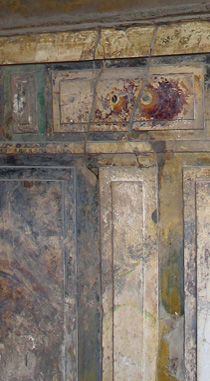 1>
1>The Wall and its Simulacra (Incrustation Style)
According to Vitruvius the creation of domestic virtual worlds by the ‘ancients’ began quite simply, with the use of paint to imitate expensive marble surfaces, “…. the ancients who introduced polished finishings began by representing different kinds of marble slabs in different positions,…” (Vitruvius Pollio (c.25BC)), The Ten Books on Architecture (7.5.1) Morris Hicky Morgan ed. http://www.perseus.tufts.edu/cgi-bin/ptext?lookup=Vitr.+7.5.1)
In so doing paint transformed the wall into a simulacrum of itself, whilst also significantly upgrading its appearance (fig.1). In addition to mimicking the colour and pattern of marble, we also learn from Vitruvius that the ancients used paint to recreate its slab-like appearance, which they further emphasized by raising the surfaces of the plaster. This use of paint and bas-relief gave the wall and the house an invented sense of solidity and monumentality. Beneath the painted veneer the wall was made of roughly cut pitted blocks of volcanic lava. No doubt aware of Vitruvius’s observation, August Mau in his highly influential publication Pompeii: Its Life and Art (1899) named this the ‘Incrustation’ Style, now generally referred to as the ‘First Style’. He dated its appearance to around 200 BC, on the basis that many of the older Oscan-Samnite houses from this period contained copious amounts of faux marble wall-painting.
As was earlier mentioned, the First Style did not only consist of imitation marble surfaces, but occasionally depicted objects hanging on the faux wall. Many of these appear to be emblematic motifs such as fillets or commemorative scarves symbolising betrothal, masks possibly signifying Dionysus or the theatre, and garlands of flowers and fruit symbolising the pagan eucharist and votive commemoration (fig.4). [For an in-depth study of the First Style see Laidlaw, A., 1985, The First Style in Pompeii: Painting and Architecture.]
|